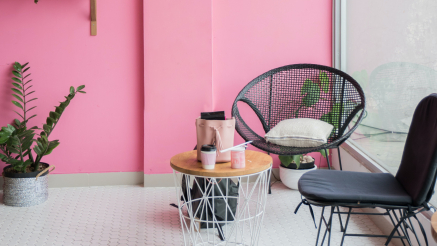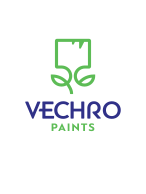
What is a Low Voc paint?
What is a Low Voc paint?
A low VOC paint is the paint that acquires low percentage of Volatile Organic Compounds.
1. What are the Volatile Organic Compounds (VOC)?
A Volatile Organic Compound is any compound that its boiling point (at a pressure of 101.3kPa) is less or equal to 250°C.
VOC can be solvents, free monomers, plasticizers etc. The VOC content can be translated into grams per liter of a product ready for use (i.e. after the addition of the recommended solvent, depending on the application).
2. Why do we choose paints and varnishes of low VOC rate?
Volatile Organic Compounds:
- They contribute to the increase of the amount of ozone in the troposphere that leads to the creation of photochemical pollution (or else the well-known “clouds”).
- Also, when they contain aromatic compounds, they pollute the water horizon.
- Furthermore, they have been accused for the “dilution” of the ozone layer in the stratosphere.
- VOC, have also been blamed for their indirect contribution to the greenhouse effect.
- Last but not least, the chronic use of VOC paints can cause respiratory problems and may affect the human nervous system.
In 2004, for Europe the total amount of VOC (mostly solvents) which released into the environment from the production and the application of paints and varnishes along with the cleaning of application tools are estimated to 550.000 tons (CEPE annual report 2004).
European Union (EU) directive 2004/42 EK seeks to limit the usage of VOC in paints and varnishes with goal to long term protect the environment and human life respectively.
The limited use of VOC will not be only applied to solvent paints but also to water-soluble paints, which already contains smaller percentage of VOC. However, they are used in order to paint and protect bigger surfaces such as walls.
3. What are the restrictions that EU Directive 2004/42 EK has imposed? When and how are they going to implement?
EU Directive 2004/42 EK introduces restriction on the overall VOC amount in building paints and varnishes as well as car paint repair products.
The container of these product should have the appropriate marking, which indicates the maximum VOC amount of the products that are ready for use, also the subcategory that they belong should be stated along with the marginal VOC amount of the subcategory.
The restrictions are also applied for the tinting systems in the sale points, by all means in the amount of VOC that the color base contain should be also included the dyes that are dosed each time.
Hence, the paints that are for industrial activities are covered by Directive 1999/13/ EK (KYA 11641/1942) as they should have the appropriate marking.
The restriction which are imposed by the Directive 2004/42/EK apply in two cases:
- 1st phase from 1.1.2007-31.12.2009
- 2nd phase from 1.1.2010 onwards
The building paints and varnishes according to Directive 2004/42/EK are classified in various subcategories as it can be observed in the following table. Each subcategory includes water-diluted paints (TYPE Y) and paints diluted with organic solvent (TYPE D). Moving on, the restrictions of the 2nd phase are rigorous and prohibitive for some of the paints and varnishes categories available on the market.
Moreover, the paint and varnishes industry is obliged from 01.01.2007 to manufacture products with low VOC amount according to the marginal values which are mentioned in corresponding column of the following table. Thus, all products which are produced before 01.01.2007 can be sold from the sale points until 31.12.2007. Respectively, a grace period of 12 months will be given also for the 2nd phase application of the restrictions (01.01.2010-31.12.2010).
From 01.01.2007 products’ label must have the appropriate marking, which indicates the category that each product belongs along with the relative marginal VOC value and the maximum VOC that is contained to a ready for use product. A product which meets the VOC value limit for the year 2007 but it does not have the appropriate marking on the pot it cannot be consider that have been complied to the Directive 2004/42/EK.
|
Greek Republic |
DECISION OF ANOTABLE CHEMICAL COUNCIL |
|
MINISTRY OF ECONOMICS |
Athens, 29 November 2005 |
|
GENERAL CHEMISTRY OF THE STATE
|
No. Prot. 437/2005 |
|
GREAT CHEMICAL COUNCIL |
|
APPENDIX I (Directive 2004/42 / EC)
LIMITED PRICES OF MAXIMUM VOC VALUES FOR BUILDING PAINTS AND VARNISHES
|
|
PRODUCT SUBCATEGORY |
Type |
1ST PHASE(g/l*) 01.01.2007 |
2ND PHASE(g/l*) (01.01.2010) |
|
Α |
Matt for interior walls and ceilings (Torque ≤25 @ 60ºC) |
Υ** D** |
75 400 |
30 30 |
|
Β |
Glossy interior walls and ceilings (Torque >25@60 ºC) |
Υ D |
150 400 |
100 100 |
|
C |
Exterior wall of mineral substrates |
Υ D |
75 450 |
40 430 |
|
D |
Exterior/Interior decorations and upholstery made of wood and metal |
Υ D |
150 400 |
130 300 |
|
Ε |
Varnishes and wood paints for interior/exterior decoration |
Υ D |
150 500 |
130 400 |
|
F |
Absorbed wood paints (wood preservatives) |
Υ D |
150 700 |
130 700 |
|
G |
Primers (with insulation and sealing properties) |
Υ D |
50 450 |
30 350 |
|
Η |
Bonding primers (surface intensity, waterproofing) |
Υ D |
50 750 |
30 750 |
|
I |
Special coatings of one component (antirust primers&paints, aluminum, galvanized, plastic surface primers, floor paints, antigraffiti, flame retardants) |
Υ D |
140 600 |
140 500 |
|
J |
Special two-components coatings (anti-corrosion primers& paints, aluminum-galvanized- plastic surface primers, floor paints, antigraffiti, flame retardants) |
Υ D |
140 550 |
140 500 |
|
J(a) |
colorful coatings (2 or more shades) decorative effect coatings |
Υ D |
150 400 |
100 100 |
|
J(b) |
coatings that give decorative effects such as Venetian stucco |
Υ D |
300 500 |
200 200 |
* g/l ready for use
Υ** water diluted paints
D** organic solvent diluted paints
4. How will the checks be done? What will be the penalties for violators?
Market audits and inspections will be carried out by the competent body (Directorate of Petrochemicals-General State Chemistry): The production and storage areas of each company that produce or import paints and varnishes (since 2008) when handling the products in the areas of use/application custom controls will be done when importing from countries outside the EU.
Penalties:
Violators of the provisions of Directive 2004/42/EK will be punished as following:
1. for sale on the market up to 100 liters of non-compliant product: € 3000 - € 5000
2. for sale on the market of larger quantities of non-compliant product: € 3000 for each additional 100 liters
3.€ 300 - € 500 for the use of non-compliant products in quantities up to 10 liters (through the fault of the user or for products that have suffered greater than the recommended dilution)
4. With a fine of € 4000 - € 5000, those who obstruct the inspection work for checking and finding violations and do not provide the necessary information to the competent authority will be punished.
Questions that we have to know their answers:
1. The building paints with low VOC values in the 2nd phase, will be less professional friendly?
It depends from the technical properties that each producer will acquire.
Vechro’s products will low VOC emissions will not change the habits of the professionals. However, they always contribute to the easiest and most effective application, in faster delivery times of the project, with the lowest possible smell and danger to the user.
2. The building paints with low VOC emission which will comply with the 2nd phase, will be products with higher cost?
It depends from the technical properties that each producer will acquire.
Vechro’s products with low VOC emissions target to offer high quality products without compromises and without increasing the costs.
3. Can the low VOC paints be characterized as ecological?
No! Paints and varnishes that have the ecological mark exceed the requirements of the Directive 2004/42/EK (even for the 2nd phase) for the low VOC emissions and they do not need any modification in their composition except in the marking of their label. Also, ecological paints meet a number of other requirements which are related to their compositions, effectiveness, coverage, durability, and their environmental behavior throughout their product life cycle. The above do not necessarily meet by a product with low VOC emissions which are comply under the requirements of Directive 2004/42/EK. The new directive does not mention the total quality of the product (such as the eco-label), only requires low VOC rate.
Vechro’s ecological paints and varnishes have the eco-label on the front of the label and the low VOC mark on the back
4. Can low VOC paints and varnishes be classified as less dangerous?
New paints & varnishes will contain fewer solvents and in this respect, will have a lower risk for the user. Danger must be indicated on their packaging with the appropriate symbols. Vechro products with low VOC do not carry any danger symbols for the user.
5. Are the building paints of low VOC ready for use? Does the sale and the use of solvents from the store abolish?
This is a wrong statement. The dilution of solvent paints is done with the appropriate solvents suggested by the manufacturer and it is depending from the method of application. Solvents will continue to be available in the stores.
6. Can a product with VOC amount that meet the requirements of 2004/42/EK since 2006 for the 1st phase be available in the market until 2010?
If a product does not exceed the VOC emissions but the pot does not mention the appropriate marking, which specifies the subcategory that it belongs, along with the limit values of VOC of each product ready for use, the producer should comply under the directions and modify the labels.
7. If a professional dilutes a product more than the recommended percentage may be accountable for it?
The professional is considered “guilty” in a possible inspection. The fine may be around €300-500.
8. Can a store sell an industrial product which is not comply with the 2004/42/EK in a metal paint store, a furniture factory?
It can be done only if the facilities of the dye house meet the conditions of KYA 11641/1942 (harmonization of Directive 1999/13/EK) and they have the appropriate license. In any other case, the sale is not allowed and the person who cut the invoice is accountable.
9. How can be recognized a product that was produced before 01.01.2007 and should be distributed between the transition period (01.01.2007-31.12.2007)?
Most producers mark their products with the production number. However, it is not always easy to decipher the year of production.
All Vechro products the coding of the production number includes the year of production with the first two digits e.g. the product Smaltoplast Extra Ecological with production number 061234 was produced in 2006.
10. Can a color base which comply with all the regulations of the 1st phase be tinted in a store with a system of other company?
This is not recommended since the total VOC that will results unknown to the color seller and may not meet the requirements of the directive! In this case, the paint seller is accountable.
We highlight that Vechro’s colorants are already of low VOC and with a small modification in their composition (during 2006) they are not containing any VOC emissions. In conclusion, each Vechro’s tinting system from 2006 does not contain any VOC emissions.




